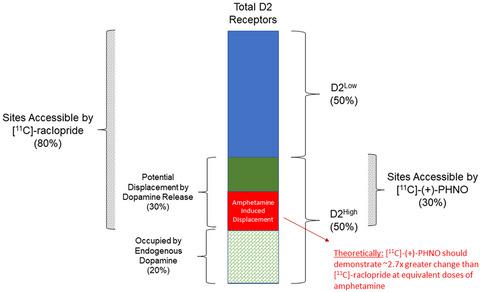Our official English website, www.x-mol.net, welcomes your
feedback! (Note: you will need to create a separate account there.)
Measuring amphetamine‐induced dopamine release in humans: A comparative meta‐analysis of [11C]‐raclopride and [11C]‐(+)‐PHNO studies
SYNAPSE ( IF 1.6 ) Pub Date : 2021-01-20 , DOI: 10.1002/syn.22195 Fernando Caravaggio 1, 2 , Natasha Porco 1 , Julia Kim 1 , Edgardo Torres-Carmona 1 , Eric Brown 1, 2 , Yusuke Iwata 3 , Shinichiro Nakajima 4 , Philip Gerretsen 1, 2 , Gary Remington 1, 2 , Ariel Graff-Guerrero 1, 2
SYNAPSE ( IF 1.6 ) Pub Date : 2021-01-20 , DOI: 10.1002/syn.22195 Fernando Caravaggio 1, 2 , Natasha Porco 1 , Julia Kim 1 , Edgardo Torres-Carmona 1 , Eric Brown 1, 2 , Yusuke Iwata 3 , Shinichiro Nakajima 4 , Philip Gerretsen 1, 2 , Gary Remington 1, 2 , Ariel Graff-Guerrero 1, 2
Affiliation

|
The radiotracers [11C]‐raclopride and [11C]‐(+)‐PHNO are commonly used to measure differences in amphetamine‐induced dopamine release between healthy persons and persons with neuropsychiatric diseases. As an agonist radiotracer, [11C]‐(+)‐PHNO should theoretically be roughly 2.7 times more sensitive to displacement by endogenous dopamine than [11C]raclopride. To date, only one study has been published comparing the sensitivity of these two radiotracers to amphetamine‐induced dopamine release in healthy persons. Unfortunately, conflicting findings in the literature suggests that the dose of amphetamine they employed (0.3 mg/kg, p.o.) may not reliably reduce [11C]‐raclopride binding in the caudate. Thus, it is unclear whether the preponderance of evidence supports the theory that [11C]‐(+)‐PHNO is more sensitive to displacement by amphetamine in humans than [11C]‐raclopride. In order to clarify these issues, we conducted a comparative meta‐analysis summarizing the effects of amphetamine on [11C]‐raclopride and [11C]‐(+)‐PHNO binding in healthy humans. Our analysis indicates that amphetamine given at 0.3 mg/kg, p.o. does not reliably reduce [11C]‐raclopride binding in the caudate. Second, the greater sensitivity of [11C]‐(+)‐PHNO is evidenced at 0.5 mg/kg, p.o., but not at lower doses of amphetamine. Third, our analysis suggests that [11C]‐(+)‐PHNO may be roughly 1.5 to 2.5 times more sensitive to displacement by amphetamine than [11C]‐raclopride in healthy persons. We recommend that future displacement studies with these radiotracers employ 0.5 mg/kg, p.o. of amphetamine with a dose, post‐scan interval of at least 3 hr. Using this dose of amphetamine, [11C]‐raclopride studies should employ at least n = 34 participants per group, while [11C]‐(+)‐PHNO studies should employ at least n = 6 participants per group, in order to be sufficiently powered (80%) to detect changes in radiotracer binding within the caudate.
中文翻译:

测量安非他明诱导的人体多巴胺释放:[11C]-雷氯必利和 [11C]-(+)-PHNO 研究的比较荟萃分析
放射性示踪剂 [ 11 C]-raclopride 和 [ 11 C]-(+)-PHNO 通常用于测量健康人和神经精神疾病患者之间苯丙胺诱导的多巴胺释放的差异。作为一种激动剂放射性示踪剂,理论上,[ 11 C]-(+)-PHNO 对内源性多巴胺置换的敏感性大约是 [ 11 C]雷氯必利的 2.7倍。迄今为止,仅发表了一项研究,比较了这两种放射性示踪剂对安非他明诱导的健康人多巴胺释放的敏感性。不幸的是,文献中相互矛盾的发现表明,他们使用的苯丙胺剂量(0.3 毫克/公斤,口服)可能无法可靠地减少 [ 11C]-raclopride 在尾状核中结合。因此,尚不清楚证据的优势是否支持[ 11 C]-(+)-PHNO 比[ 11 C]-雷氯必利对人体苯丙胺置换更敏感的理论。为了澄清这些问题,我们进行了一项比较性荟萃分析,总结了安非他明对健康人中 [ 11 C]-雷氯必利和 [ 11 C]-(+)-PHNO 结合的影响。我们的分析表明,口服 0.3 mg/kg 的苯丙胺不能可靠地降低尾状核中的 [ 11 C]-雷氯必利结合。其次,[ 11 C]-(+)-PHNO 在 0.5 mg/kg、po 时的敏感性更高,但在较低剂量的安非他明下则不然。第三,我们的分析表明 [在健康人中,11 C]-(+)-PHNO 对苯丙胺置换的敏感性大约是 [ 11 C] -雷氯必利的 1.5 到 2.5 倍。我们建议未来使用这些放射性示踪剂进行的置换研究采用 0.5 mg/kg 的苯丙胺口服剂量,扫描后间隔至少为 3 小时。使用该剂量的安非他明,[ 11 C]-雷氯必利研究应每组至少雇用n = 34 名参与者,而 [ 11 C]-(+)-PHNO 研究应每组至少雇用n = 6 名参与者,以便有足够的动力 (80%) 以检测尾状核内放射性示踪剂结合的变化。
更新日期:2021-03-11
中文翻译:

测量安非他明诱导的人体多巴胺释放:[11C]-雷氯必利和 [11C]-(+)-PHNO 研究的比较荟萃分析
放射性示踪剂 [ 11 C]-raclopride 和 [ 11 C]-(+)-PHNO 通常用于测量健康人和神经精神疾病患者之间苯丙胺诱导的多巴胺释放的差异。作为一种激动剂放射性示踪剂,理论上,[ 11 C]-(+)-PHNO 对内源性多巴胺置换的敏感性大约是 [ 11 C]雷氯必利的 2.7倍。迄今为止,仅发表了一项研究,比较了这两种放射性示踪剂对安非他明诱导的健康人多巴胺释放的敏感性。不幸的是,文献中相互矛盾的发现表明,他们使用的苯丙胺剂量(0.3 毫克/公斤,口服)可能无法可靠地减少 [ 11C]-raclopride 在尾状核中结合。因此,尚不清楚证据的优势是否支持[ 11 C]-(+)-PHNO 比[ 11 C]-雷氯必利对人体苯丙胺置换更敏感的理论。为了澄清这些问题,我们进行了一项比较性荟萃分析,总结了安非他明对健康人中 [ 11 C]-雷氯必利和 [ 11 C]-(+)-PHNO 结合的影响。我们的分析表明,口服 0.3 mg/kg 的苯丙胺不能可靠地降低尾状核中的 [ 11 C]-雷氯必利结合。其次,[ 11 C]-(+)-PHNO 在 0.5 mg/kg、po 时的敏感性更高,但在较低剂量的安非他明下则不然。第三,我们的分析表明 [在健康人中,11 C]-(+)-PHNO 对苯丙胺置换的敏感性大约是 [ 11 C] -雷氯必利的 1.5 到 2.5 倍。我们建议未来使用这些放射性示踪剂进行的置换研究采用 0.5 mg/kg 的苯丙胺口服剂量,扫描后间隔至少为 3 小时。使用该剂量的安非他明,[ 11 C]-雷氯必利研究应每组至少雇用n = 34 名参与者,而 [ 11 C]-(+)-PHNO 研究应每组至少雇用n = 6 名参与者,以便有足够的动力 (80%) 以检测尾状核内放射性示踪剂结合的变化。











































 京公网安备 11010802027423号
京公网安备 11010802027423号